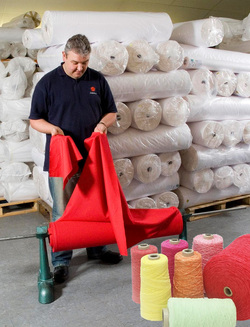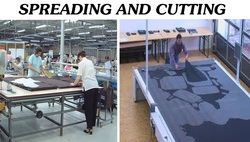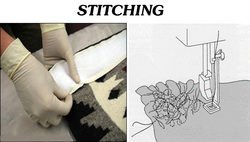GUIDELINE FOR PRODUCTION & QUALITY (GPQ)
A. For Quality safety need a Quality Control Guideline Every time, Every where,Every subjects. Here is explanation a Quality Control Guideline for Export-Quality Garments Industries to control the quality before and during production. Please study carefully and make sure all production Staff/Supervisors and Operators they are fully understand and work correctly.
GUIDE LINE FOR SHIRTS

1. Fabric Should check the fabric and make sure there are no quality defect before start spreading and cutting.
a. Fabric defects such as Coarse yarn,Shading, Missing Yarn, Dirty stain etc.
b. Fabric is in off shading, it should be rejected.
2. Bulk Accessories Card Should have Accessories card for Supervisors to Cheek frequency and avoid wrongly use Accessories.
3. Approval Sample Supervisors should use approval sample together with Buyer comments to cheek frequency to avoid any wrong work in bulk production.
Most important is factory technical staff can study the approval sample to look if have any major point should be take care in production in order to prevent problems from beginning and before production start.
Any operation in starting stage, Supervisors must teach and make sure all operators work correctly.
4.Fusible Interlining Make sure the right type of fusible interlining is to be used to avoid
(a) Yellowish shade
(b) fail in fusing test.
5. Spreading and Cutting Fabric do not pile up too high otherwise it will caused not accurate cutting.
6. Bundling and Ticketing
(a) Do not mix up the cutting components
(b) One bundle only contain in one roll fabric cutting components, Otherwise it will caused garment color shading.
7. Interlining Fusing-Must use correct fusible interlining to avoid yellowish shade and pass fusing test after interlining fused.The Timing, Temperature, Pressure must be test and correct before fusing operation start in order to avoid.
(a) Not complete fusing, Fabric and interlining will be separated after washing.
(b) Overheat to cause Yellowish shade. On stretch fabric the interlining mist also stretch and have compatible extension.
The colour of the interlining must be compatible with that of the shall materiel.
The size of the interlining must be adjusted to the article and it must be carefully attached.
The attachment on the interlining must not distort the fabric.
Fusible interlinings must be fused permanently to the fabric and with correct setting conditions, which have been recommended by the producer.
Fly and other contamination must not be out allowed between the interlining and fabric.
Interlining adhesive must not be the face of the fabric, due to strike through or soil age.
8. Threads :-
Threads must be color fast and compatible with shell material and lining with regard to Breaking strength/Elasticity/Heat/Resistance/Shrinkage,
Mono filament thread is not allowed.
Cotton thread is not allowed, except for garment dyed merchandise.
a. Fabric defects such as Coarse yarn,Shading, Missing Yarn, Dirty stain etc.
b. Fabric is in off shading, it should be rejected.
2. Bulk Accessories Card Should have Accessories card for Supervisors to Cheek frequency and avoid wrongly use Accessories.
3. Approval Sample Supervisors should use approval sample together with Buyer comments to cheek frequency to avoid any wrong work in bulk production.
Most important is factory technical staff can study the approval sample to look if have any major point should be take care in production in order to prevent problems from beginning and before production start.
Any operation in starting stage, Supervisors must teach and make sure all operators work correctly.
4.Fusible Interlining Make sure the right type of fusible interlining is to be used to avoid
(a) Yellowish shade
(b) fail in fusing test.
5. Spreading and Cutting Fabric do not pile up too high otherwise it will caused not accurate cutting.
6. Bundling and Ticketing
(a) Do not mix up the cutting components
(b) One bundle only contain in one roll fabric cutting components, Otherwise it will caused garment color shading.
7. Interlining Fusing-Must use correct fusible interlining to avoid yellowish shade and pass fusing test after interlining fused.The Timing, Temperature, Pressure must be test and correct before fusing operation start in order to avoid.
(a) Not complete fusing, Fabric and interlining will be separated after washing.
(b) Overheat to cause Yellowish shade. On stretch fabric the interlining mist also stretch and have compatible extension.
The colour of the interlining must be compatible with that of the shall materiel.
The size of the interlining must be adjusted to the article and it must be carefully attached.
The attachment on the interlining must not distort the fabric.
Fusible interlinings must be fused permanently to the fabric and with correct setting conditions, which have been recommended by the producer.
Fly and other contamination must not be out allowed between the interlining and fabric.
Interlining adhesive must not be the face of the fabric, due to strike through or soil age.
8. Threads :-
Threads must be color fast and compatible with shell material and lining with regard to Breaking strength/Elasticity/Heat/Resistance/Shrinkage,
Mono filament thread is not allowed.
Cotton thread is not allowed, except for garment dyed merchandise.
FABRIC AND YARN

FABRIC RELAXATION : - As a general rule all knitted fabrics and woven fabrics containing elastomeric yarn (e,g spandex / elastane) need to be relaxed before spreading and cutting, This helps to reduce the relaxation shrinkage and prevent shrinkage.
Accessories : - All accessories must comply with the PSTD Quality Standards and Requirements, PSTD Safety Requirements for Babies and Children wear and PSTD Chemical Restrictions.
Accessories include: Threads, Buttons, Badges, Zippers, Interlinings, Drawstrings,. Stoppers, Labels, Hang Tags, Price Tags, /etc.It is important that their appearance is identical to the accessories approved by PSTD Trim cards must be kept.
Metal accessories for Babies and Children wear must be ferrous free. Care label print must be wash proof and readable during the useful life of the product.
Elastic must be pre-shrunk and relaxed before sewn into the garment. PSTD recommends buttons for all garments to be attached with a lock stitch machine.
Buttons for children garments must be attached with a lock stitch machine. All suppliers for children must have a safe button and accessory testing machine.All accessories like buttons, rivets, bows erc must be tested for fastness.
Threads must be in correct quality to keep its strength, also after heavy garment washes.
PRODUCTION : Before production can start, the suppliers must conduct per production meetings. style by style, and discuss how to produce the goods with a consistent quality.The will help to identify the number and type of controls and tests that are going to be required. All persons involved.
before and during the production must attend this meeting. Keep a record from the meeting.
Accessories : - All accessories must comply with the PSTD Quality Standards and Requirements, PSTD Safety Requirements for Babies and Children wear and PSTD Chemical Restrictions.
Accessories include: Threads, Buttons, Badges, Zippers, Interlinings, Drawstrings,. Stoppers, Labels, Hang Tags, Price Tags, /etc.It is important that their appearance is identical to the accessories approved by PSTD Trim cards must be kept.
Metal accessories for Babies and Children wear must be ferrous free. Care label print must be wash proof and readable during the useful life of the product.
Elastic must be pre-shrunk and relaxed before sewn into the garment. PSTD recommends buttons for all garments to be attached with a lock stitch machine.
Buttons for children garments must be attached with a lock stitch machine. All suppliers for children must have a safe button and accessory testing machine.All accessories like buttons, rivets, bows erc must be tested for fastness.
Threads must be in correct quality to keep its strength, also after heavy garment washes.
PRODUCTION : Before production can start, the suppliers must conduct per production meetings. style by style, and discuss how to produce the goods with a consistent quality.The will help to identify the number and type of controls and tests that are going to be required. All persons involved.
before and during the production must attend this meeting. Keep a record from the meeting.
TRIAL CUTTING

PSTD Recommends that Supplier to do a trial cutting before production stats. Finish 200-300 Pieces covering all sizes and colors. At this stage it is easier to find and solve problems that otherwise can occur during production.
SPREADING AND CUTTING

Splices. both layers must overlap past the marked splice.
Tension must be checked during spreading.
Fabrics containing elastomeric yarn to be relaxed before cutting. Jersy- all parts in the same garment of the quality must be cut from the same dye lot. Woven -all parts in the same garment of same quality must be cut from the same layer consisting of the same dye lot.
From directional fabric all parts in the same garment should be cut in the same direction. All garments in the same order should be cut in the same direction, if no other agreement is stated on order.
Ply height must be suitable according to fabric type.
All patten pieces on marker must be placed on correct grain line.
Pattern pieces must not be damaged or overlapping when markers are drawn.
All Parts in the same woven garment of the same quality must be cut from the same layer.
All parts in the same jersy garment of the same quality must be cut from the same dye lot.
Tension must be checked during spreading.
Fabrics containing elastomeric yarn to be relaxed before cutting. Jersy- all parts in the same garment of the quality must be cut from the same dye lot. Woven -all parts in the same garment of same quality must be cut from the same layer consisting of the same dye lot.
From directional fabric all parts in the same garment should be cut in the same direction. All garments in the same order should be cut in the same direction, if no other agreement is stated on order.
Ply height must be suitable according to fabric type.
All patten pieces on marker must be placed on correct grain line.
Pattern pieces must not be damaged or overlapping when markers are drawn.
All Parts in the same woven garment of the same quality must be cut from the same layer.
All parts in the same jersy garment of the same quality must be cut from the same dye lot.
STITCHING

UPSTD recommends working with a line system.This is to maintain a continuous quality level throughout the production.QC must work on the production floor and at the end of the lines. supervisors must ambulate the floor.
Production must be stopped when a problem occurs. The problem source must be found and solved before production can start again. Records are to be kept.
Mechanics should take care of the mechanics maintenance. All machines should be checked on a regular basis. A service contract with the machine company can be recommended.
The machine operators are responsible of making sure that their machine runs according to standard. In case of problem the supervisor or mechanic should be contacted.
Broken needle records are to be kept. All broken parts are to be taped into a log book.
Production must be stopped when a problem occurs. The problem source must be found and solved before production can start again. Records are to be kept.
Mechanics should take care of the mechanics maintenance. All machines should be checked on a regular basis. A service contract with the machine company can be recommended.
The machine operators are responsible of making sure that their machine runs according to standard. In case of problem the supervisor or mechanic should be contacted.
Broken needle records are to be kept. All broken parts are to be taped into a log book.
KNITTING

All Panels in one garment should be knitted on the same machine QC must work on the production floor. Supervisors must ambulate the floor.
Production must be stopped when a problem occer. The problem source must be found and solved before production can again . Records are to be kept.
TRIMMING :- Trimming should be taken care of throughout the stitching process. Only final trimming is done in the finishing area before packing.
PRESSING :- Heat to be adjusted to the material and the style.
To avoid shine marks, a teflon cover must be used.
For Heavy and Fine knit-it is recommended to use a mould when pressing the garment,in order to maintain the correct shape of the garment.
NEEDLE DETECTION :- A needle detector must be for checking baby and children garments. PSTD standard is 1.00 to 1.20 mm diameter sphere of ferrous metal.
TRANSPORT AND PACKING :- The packing must be done in accordance with PSTD delivery and trading conditions..
Carton size and quality must be according to what is requested on order sheet and mentioned PSTD delivery and trading condition. During packing the goods must be protected from insects. Windows and doors in the packing premises must either be closed or equipped with net or any other suitable cover.
an audit of the packing must be done.
STORAGE :- Cartons should be stored country wise.
Cartons should be stored on pallets, to prevent water damage or soiled goods during stprage.
Hanging shipments should be country wise, by size and colour shipment be stored country wise bt size and colour Goods should be coverd with appropriate poly bags ;packing materials.
Production must be stopped when a problem occer. The problem source must be found and solved before production can again . Records are to be kept.
TRIMMING :- Trimming should be taken care of throughout the stitching process. Only final trimming is done in the finishing area before packing.
PRESSING :- Heat to be adjusted to the material and the style.
To avoid shine marks, a teflon cover must be used.
For Heavy and Fine knit-it is recommended to use a mould when pressing the garment,in order to maintain the correct shape of the garment.
NEEDLE DETECTION :- A needle detector must be for checking baby and children garments. PSTD standard is 1.00 to 1.20 mm diameter sphere of ferrous metal.
TRANSPORT AND PACKING :- The packing must be done in accordance with PSTD delivery and trading conditions..
Carton size and quality must be according to what is requested on order sheet and mentioned PSTD delivery and trading condition. During packing the goods must be protected from insects. Windows and doors in the packing premises must either be closed or equipped with net or any other suitable cover.
an audit of the packing must be done.
STORAGE :- Cartons should be stored country wise.
Cartons should be stored on pallets, to prevent water damage or soiled goods during stprage.
Hanging shipments should be country wise, by size and colour shipment be stored country wise bt size and colour Goods should be coverd with appropriate poly bags ;packing materials.
